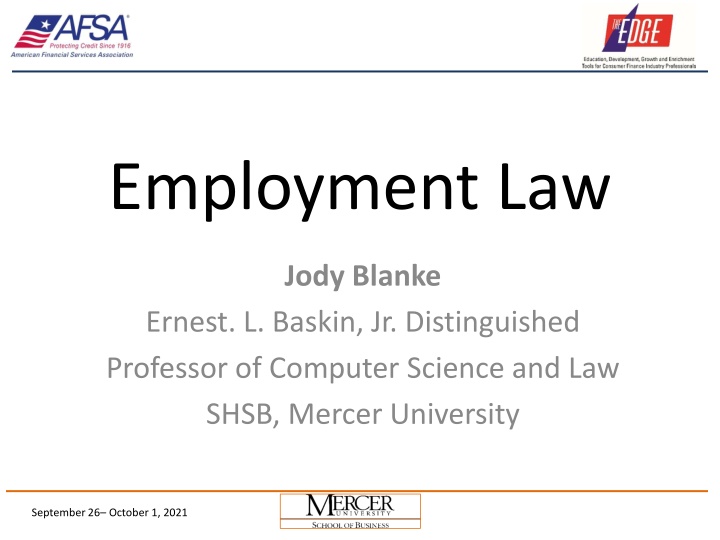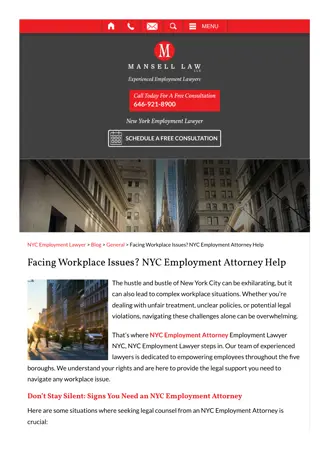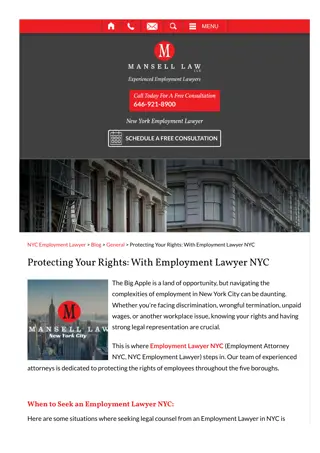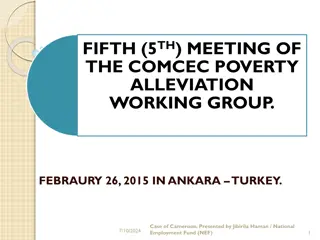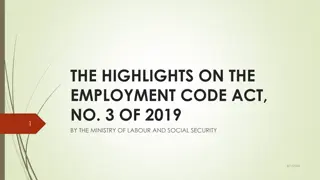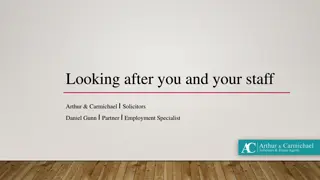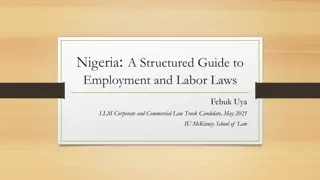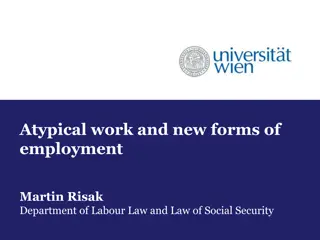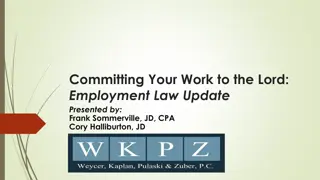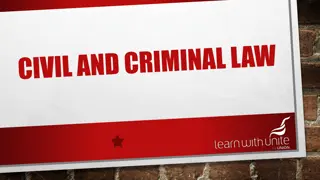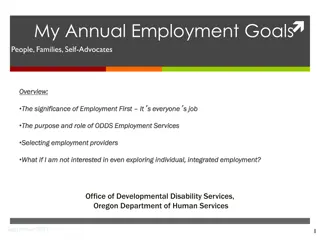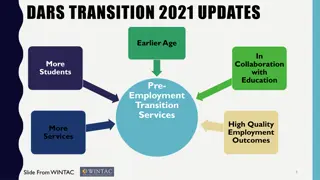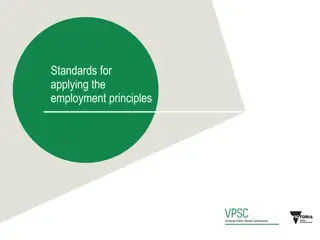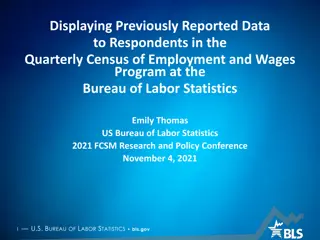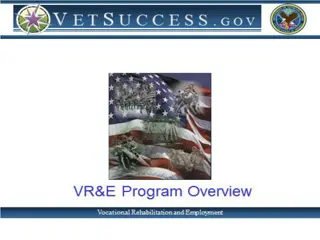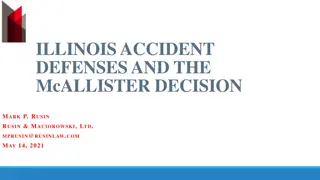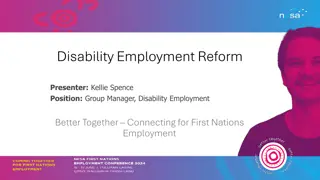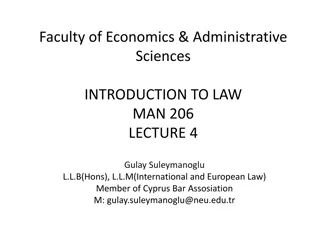Overview of Employment Law
Employment law encompasses a wide range of regulations governing the relationship between employers and employees. This includes topics such as at-will employment, wrongful discharge exceptions, and employment discrimination laws. Important federal laws like Title VII of the Civil Rights Act of 1964 and the Age Discrimination in Employment Act of 1967, as well as state-specific laws, play a crucial role in shaping the legal landscape of the workplace. Understanding these laws is essential for both employers and employees to navigate the complexities of the modern workplace.
Download Presentation

Please find below an Image/Link to download the presentation.
The content on the website is provided AS IS for your information and personal use only. It may not be sold, licensed, or shared on other websites without obtaining consent from the author.If you encounter any issues during the download, it is possible that the publisher has removed the file from their server.
You are allowed to download the files provided on this website for personal or commercial use, subject to the condition that they are used lawfully. All files are the property of their respective owners.
The content on the website is provided AS IS for your information and personal use only. It may not be sold, licensed, or shared on other websites without obtaining consent from the author.
E N D
Presentation Transcript
Employment Law Jody Blanke Ernest. L. Baskin, Jr. Distinguished Professor of Computer Science and Law SHSB, Mercer University September 26 October 1, 2021
Employment Law Primarily state law varies from state to state A good bit of federal law, too mostly discrimination law September 26 October 1, 2021
At-Will Employment Generally, an employee can be fired for good reason You ve been stealing from us. You re fired! can be fired for no reason I don t like the color of your shoes. You re fired! cannot be fired for bad reason You re black. You re fired! September 26 October 1, 2021 3
At-Will Employment Wrongful discharge exceptions vary greatly by state 1. Public policy exceptions e.g., whistleblower statutes recognized by 43 states 2. Implied contract exceptions e.g., employee handbooks recognized by 42 states September 26 October 1, 2021
At-Will Employment 3. Implied covenant of good faith and fair dealing exceptions recognized by 20 states Fifteen states recognize all 3 exceptions Alaska, Arizona, Arkansas, California, Connecticut, Idaho, Illinois, Massachusetts, Nevada, New Hampshire, New Jersey, Oklahoma, Pennsylvania, South Carolina, Vermont, Wyoming Three states recognize none of the exceptions Florida, Georgia, Rhode Island September 26 October 1, 2021
Employment Discrimination Civil Rights Act of 1866 Title VII of the Civil Rights Act of 1964 Age Discrimination in Employment Act of 1967 (ADEA) Uniformed Services Employment and Reemployment Rights Act of 1994 (USERRA) September 26 October 1, 2021 6
Employment Discrimination Immigration Reform and Control Act of 1986 (IRCA) Americans with Disabilities Act of 1990 (ADA) Americans with Disabilities Amendments Act of 2008 (ADAAA) Genetic Information Nondiscrimination Act of 2008 (GINA) September 26 October 1, 2021
Title VII Prohibits discrimination on the basis of: Race Color Gender Religion National origin September 26 October 1, 2021 8
Title VII For purposes of making decisions regarding: Hiring Firing Training Discipline Compensation Benefits Classification Other terms or conditions of employment September 26 October 1, 2021 9
Title VII Applies to all public (federal, state and local) and private employers with 15 or more employees Covers all levels of employees (managerial and hourly) Exemption - permits religious institutions and associations to discriminate when performing their activities September 26 October 1, 2021 10
Hosanna-Tabor Church v. EEOC (2012) The Supreme Court recognized a ministerial exception to employment discrimination laws A teacher taught mostly secular subjects, but also taught religion classes and attended chapel with class (about 45 minutes per day) The Establishment Clause prevents the government from appointing ministers and the Free Exercise Clause prevents it from interfering with the freedom of religious groups to select their own. Majority Roberts. The question whether an employee is a minister is itself religious in nature and should be left to the religious group. Concurrence Thomas. It would be a mistake to focus on the term minister because many religions do not use it. Rather, the exception should apply to any employee who leads a religious organization, conducts worship services or important religious ceremonies or rituals, or serves as a messenger or teacher of its faith. Concurrence Alito and Kagan. September 26 October 1, 2021
Filing Claims under Title VII Employee files a claim with the EEOC EEOC notifies the employer Title VII includes anti-retaliatory provisions Mediation EEOC investigation No-Reasonable-Cause Finding EEOC issues employee a right-to-sue letter Exhaustion of administrative remedies Reasonable-Cause Finding Conciliation Civil suit filed in federal district court September 26 October 1, 2021 12
Theoretical Bases for Title VII Lawsuits Disparate Treatment Disparate Impact September 26 October 1, 2021 13
Disparate Treatment Employee s Prima Facie Case: Employee is a member of the class of persons protected by Title VII, Employee applied for and was qualified for a job for which the employer was seeking applicants, That despite these qualifications, employee was rejected, and After this rejection, the position remained open and the employer continued to seek applicants with those same qualifications. September 26 October 1, 2021 14
Disparate Treatment Employer s Defense: Employer can defend by showing that it had a legitimate, nondiscriminatory reason for its decision. Employee s Counter: Employee must prove that the grounds offered by the employer were merely a pretext for its actions and that discrimination was the real reason. e.g., McDonnell Douglas Corp. v. Green (1973) Black civil rights activist protested after being laid off and was not rehired when new position became available. Supreme Court remanded case to give Green a chance to prove pretext. Established the framework for employment discrimination cases September 26 October 1, 2021 15
Disparate Treatment Employer may defend by showing that there is a bona fide occupational qualification (BFOQ) Available only in cases involving gender, religion and national origin (not for race or color). Some circuits use a two-step test: Does the particular job require that the employee be of one gender only, and if so Is that requirement reasonably necessary to the essence of the employer s business? e.g., flight attendants at Southwest Airline? No e.g., bunnies at Playboy Clubs? Yes e.g., servers at Hooters? No September 26 October 1, 2021 16
Disparate Impact Discrimination can be established by proving that an employment practice, although neutral on its face, disproportionately affects a protected group in a negative way. Courts have determined the that the following screening devices have a disparate impact: Educational requirement race, e.g., Griggs v. Duke Power (1971) Credit status gender, race Height and weight requirements gender, national origin September 26 October 1, 2021 17
Disparate Impact The Four-Fifths Rule is a rule of thumb that permits a 20% margin between the outcomes of the majority and the minority under a given screening device i.e., disparate impact is statistically demonstrated when the rate for a protected group is less than 80% (or four-fifths) of the higher scoring majority group Employer can rebut the employee s prima facie case by showing the existence of a business necessity e.g., requirement of credit history may result in fewer women hired, but handling large sums of money may warrant credit check Employee would then have to prove that there is a means of addressing the issue that has less of an adverse impact September 26 October 1, 2021 18
Sexual Harassment Quid Pro Quo Harassment Employee is required to engage in sexual activity in exchange for promotions, raises or continued employment Hostile Environment Harassment The harassment is unwelcome activity The harassment is based upon gender The harassment is sufficiently severe or pervasive to create an abusive working environment The harassment affects a term or condition of employment The employer had actual or constructive notice of the hostile environment and took no prompt or adequate remedial action September 26 October 1, 2021 19
Employer Liability Employers are vicariously liable under the doctrine of respondeat superior for all torts committed by employees acting within the scope of employment. Employers may also be liable for torts committed by employees not working within the scope of employment if the employer intended the conduct, the employee s high rank makes him the employer s alter ego, the employer was negligent, or the employee was aided in accomplishing the tort by the existence of the agency relation. September 26 October 1, 2021 20
Employer Liability Employers are strictly liable for quid pro quo sexual harassment, i.e., when there are tangible employment actions taken. Employers are not strictly liable if there is no tangible employment action. In these hostile environment cases, the employer can use the Faragher/Ellerth defense to show that it had a reasonable antidiscrimination policy in place, but that the harassed employee unreasonably failed to use it. September 26 October 1, 2021 21
Faragher v. Boca Raton (1998) Supreme Court found the city (employer) liable for the sexual harassment of its lifeguard supervisors. Court held that while the city had available to it an affirmative defense to show that it exercised reasonable care to prevent and correct promptly any sexually harassing behavior, it had failed to do so as a matter of law. September 26 October 1, 2021 22
Burlington Ind. v. Ellerth (1998) Supreme Court held that employer might be liable for hostile work environment, but should have an opportunity to prove that employee unreasonably failed to take advantage of employer s complaint procedure. Employee suffered no tangible employment action (and was even promoted during her employment). Employee worked for employer for about 15 months, but didn t report the harassment until a few weeks after leaving. Her supervisor had made remarks about her breasts, had told her top loosen up and warned, you know, Kim, I could make your life very hard or very easy at Burlington. He told her she was not loose enough and reached over and rubbed her knee. He responded to a job-related question from her, I don t have time for you right now, Kim unless you want to tell me what you re wearing. A couple of days later, he again responded, are you wearing shorter skirts yet, Kim, because it would make your job a whole heck of a lot easier. September 26 October 1, 2021 23
Policies It is important to have a policy It is important to inform employees about the policy It is important to enforce the policy September 26 October 1, 2021
Other Harassment Hostile environment harassment claims under Title VII on the basis of race, color, national origin or religion are also evaluated by looking at the totality of the environment. September 26 October 1, 2021 25
Ricci v. Destefano (2009) The City of New Haven gave firefighter exams in 2003 Of the 77 candidates for lieutenant, 25 of the 43 white candidates, 6 of the 19 black candidates, and 3 of the 15 Hispanic candidates passed the exam. Of the 41 candidates for captain, 16 of the 25 white candidates, 3 of the 8 black candidates, and 3 of the 8 Hispanic candidates passed the exam. Applying the City s rule of three, all of the top 10 candidates for lieutenant were white, and 7 of the top 9 candidates for captain were white, while the other 2 were Hispanic. The City decided not to certify the exam results. September 26 October 1, 2021
Ricci v. Destefano (2009) Supreme Court held that New Haven engaged in express, race-based decisionmaking, i.e., disparate treatment, by failing to certify the exams. The Court stated that the City s action might have been justified if there was a strong basis in evidence of a disparate impact, but that was lacking as there was no dispute that the exams were job-related and consistent with business necessity (nor was there presented a less discriminatory testing alternative). September 26 October 1, 2021 27
Age Discrimination Age Discrimination in Employment Act (ADEA) applies to all public and private employees with at least 20 employees covers employees aged 40 and above. While enforced by the EEOC, it differs from Title VII More lenient regarding adverse employment decisions employer can rebut a prima facie case by showing any reasonable factor other than age. An action is not barred if another protected member is treated better, e.g., an action by a 62-year old is not barred because the replacement was a 55-year old No protection form reverse discrimination for those under 40 September 26 October 1, 2021 28
Age Discrimination Prima facie case: Employee is in protected class Employee was terminated or demoted Employee was performing job well enough to meet employer s expectations Others not in the protected class were treated more favorably. Employer s Defense Bona Fide Occupational Qualification (BFOQ) Age limit is reasonable necessary to essence of employer s business All or substantially all of the individuals over that age are unable to adequately perform the job requirements , or Some of the individuals over that age possess a disqualifying trait that cannot be ascertained except by reference to age September 26 October 1, 2021 29
Disability Discrimination The Americans with Disability Act (ADA) prohibits employers from discriminating against a qualified individual with a disability with regard to application, hiring, advancement, discharge, compensation and training. The ADA applies to all private employers with 15 or more employees. The ADA requires employers to make reasonable accommodations for requesting employees who have a physical or mental impairment that substantially limits a major life activity. September 26 October 1, 2021 30
Definition of Disability Very broad definition, but does not include Morbid obesity (unless the result of a physiological condition) Lack of an education Having a prison record Specifically excluded under ADA: Homosexuality Bisexuality Sexual-behavior disorders Compulsive gambling Kleptomania Pyromania September 26 October 1, 2021 31
Reasonable Accommodation The ADA requires employers to make reasonable accommodations as long as doing so does not cause the employer undue hardship. This includes: Making work facilities accessible Restructuring jobs or modifying work schedules Reassigning individuals to other jobs Acquiring or modifying equipment or devices Modifying examinations, training materials, or policies Providing qualified readers or interpreters September 26 October 1, 2021 32
Employer Defenses Undue Hardship The ADA defines an undue hardship as an activity requiring significant difficulty or expense in light of a variety of financial, logistical and other factors. Business Necessity Tests and standards may be acceptable under the ADA if they are related to the job and consistent with business necessity. Permissible Exclusion A disabled person may be excluded from an employment opportunity only if, by reason of the disability, he or she (with or without reasonable accommodation) cannot perform the essential functions of the job or if the individual s employment poses a significant risk to the health or safety of themselves or others. September 26 October 1, 2021 33
Employment Arbitration Agreements Arbitration agreements have become very common. Can preclude claims of discrimination by the employee against the employer, but the EEOC can still sue the company on employee s behalf. Cannot preclude class actions or joining together with others to pursue employment-related claims in court or arbitration. September 26 October 1, 2021
Covenants Not to Compete Non-employment related related to sale of business e.g., Joe the Baker Employment-related September 26 October 1, 2021
Brenda Wood Brenda Wood agreed not to work as an on- air news anchor in the Atlanta/Athens television market for 6 months. September 26 October 1, 2021
Covenants Not to Compete Scope agreement must specify what activity is to be limited Geography be careful of terms like Atlanta Duration e.g., 6 months, 1 year, 2 years September 26 October 1, 2021
Laws Vary From State to State California, Colorado and Oregon will not enforce such an agreement as an illegal restraint of trade Georgia used to be very strict about enforcement of these covenants would not blue pencil such an agreement September 26 October 1, 2021
Election Day 2010 Georgia Constitutional Amendment Shall the Constitution of Georgia be amended so as to make Georgia more economically competitive by authorizing legislation to uphold reasonable competitive agreements? 68% said Yes September 26 October 1, 2021
O.C.G.A. 13-8-50 et seq. Courts may now blue pencil the agreement Two years is presumed reasonable Need not specify a geographic restriction Law targets key employees executive employees employees in possession of important confidential information, or employees with specialized skills, knowledge, or customer contacts or information September 26 October 1, 2021
Privacy in the Workplace Reasonable expectation of privacy Your home is your castle Your workplace not so much Expectation of privacy -> approaching zero September 26 October 1, 2021
Federal Privacy Laws Apply only to federal agencies Freedom of Information Act (FOIA) (1966, re-titled in 1986) Privacy Act (1994) Very sectoral in approach Fair Credit Reporting Act (FCRA) (1970) Fair and Accurate Credit Transactions Act (FACTA) (2003) Electronics Communications Privacy Act (ECPA) (1986) Video Privacy Protection Act (1988) revised in 2013 42 September 26 October 1, 2021
Federal Privacy Laws (cont.) Health Insurance Portability and Accountability Act (HIPAA) (1996) modified by the Health Information Technology for Economic and Clinical Health Act (HITECH) (2009) Children s Online Privacy Protection Act (COPPA) (1998) revised in 2013 Gramm-Leach-Bliley Act (GLB) (1999) Controlling the Assault of Non-Solicited Pornography and Marketing Act (CAN-SPAM) (2003) Genetic Information Nondiscrimination Act (GINA) 2008 43 September 26 October 1, 2021
Fair Information Privacy Practices (FIPPs) Notice/Awareness Choice/Consent Access/Participation Integrity/Security Enforcement/Redress 44 September 26 October 1, 2021
EU Data Protection 1995 Data Protection Directive 2018 General Data Protection Regulation May 26, 2018 Right to be Forgotten 45 September 26 October 1, 2021
46 California Consumer Privacy Act Passed in 2018 under threat of stricter law by way of ballot initiative Took effect on January 1, 2020 September 26 October 1, 2021
47 California Privacy Rights Act (CCPA 2.0) Passed in November 2020 Will take effect in January 2023 Strengthens many provisions of the CCPA September 26 October 1, 2021
48 Virginia Consumer Data Protection Act Signed into law March 2, 2021 Will take effect in January 2023 September 26 October 1, 2021
49 Colorado Privacy Act Signed into law July 8, 2021 Will take effect in January 2023 September 26 October 1, 2021
50 September 26 October 1, 2021
